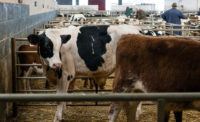As more meat processors, retailers and restaurant companies begin to ponder their approach to handling the issues associated with animal welfare, the advisory board concept is becoming increasingly common to help decision makers get the information they need. There isn’t a perfect roadmap to success for building an advisory board, but if your company is giving it some thought, here are a few things to add to your checklist.
Find a champion
One of the most important pieces of a successful animal welfare advisory board is a chairperson who can champion the effort. This person needs to be special. He or she needs to be a leader, an excellent communicator and someone who can handle conflict if it occurs. It is not necessary for this leader to know the intricate details of all types of animals that provide raw materials for your process. This person needs to be a catalyst for collaboration.
Find reputable subject matter experts
This part of the process is often handled by the chair of the board or a small internal committee. One of the most important questions to ask when selecting subject matter experts is, “Will this person tell me what I want to hear or will he tell me what I need to hear?” Most often, subject matter experts will come from the population of scientists and veterinarians that work with the specific food animals that provide your raw materials. It is a great idea to take the time to interview your potential experts to get a general idea of whether they will provide what you need. Look for someone with a practical understanding of what it takes to produce animals for food and the ability to read and understand the scientific literature and data that will be used to inform decisions.
Include your stakeholders
In most cases, a meat processor, retailer or restaurant company will be at least a link or two downstream of live-animal production in the supply chain. It is important that the closest representatives to live-animal production have a place on the board. If your company decides to pursue changes in raw material sourcing or production, these representatives are vital to developing plans that actually work. They also help carry the message back to suppliers as changes develop.
Strive for cohesion
A significant portion of the collegiality of an Animal Welfare Advisory Board seems to trickle down from the chair. One of the qualities of great leaders is the ability to “set the tone.” A great chairperson will establish a level of professional respect among members of the board. This baseline level of respect is vital to the productivity of the board. If members within or between species groups engage in infighting, it is obvious everyone is not working toward a common goal.
The second ingredient in developing and maintaining cohesion within the board is the selection of board members who are professional enough to handle differences of opinion and work through them. The interview and screening process will help to find these professionals, but sometimes success in this space boils down to good luck.
The final ingredient for cohesion is limiting the size of the group of the core members on the board. Too few people results in limited expertise; too many members can increase the chance of infighting. Many successful boards consist of two or three core members per species, which includes one or two subject experts and one or two supplier representatives.
Know the boundaries
One of the first ideas that must be defined by the company and fully understood by the board is where the supply chain boundaries lie. A vertically integrated company that owns the entire process from conception to case-ready will have the ability to affect any part of live production it chooses. Companies that source raw materials from their suppliers without a direct link to live-animal production will need to work collaboratively with their suppliers. This is another reason why it is so important to grant suppliers seats on the board. If a company does not source any raw materials from a specific species of food animal, this serves as an obvious boundary. An advisory board only needs members that represent the species of animals that supply raw materials directly to the company.
Make it meaningful
After developing an understanding of what animal welfare means to your company and the role your company has to play, it is important to commit to playing that role. A productive Animal Welfare Advisory Board should work steadily to respond to current issues in food animal production and keep an eye on the issues that are on the horizon. Part of making the work of the board meaningful is to use it as a tool for continuous improvement. In the end, the effort of the board should yield results that contribute to the sustainability of the company, the well-being of the animals and farmers, and public faith in the supply chain.





Report Abusive Comment